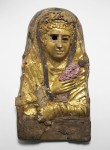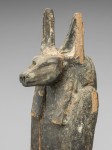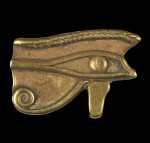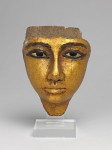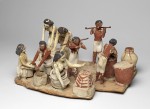 A tiny ancient Egyptian coffin previously believed to hold mummified organs has been found to contain the youngest known example of a mummified fetus. Mummified fetuses are rare in the archaeological record of ancient Egypt. Two mummified fetuses in coffins were found in Tutankhamun’s tomb, but they were at about 25 weeks and 37 weeks gestation. This one is only 16 to 18 weeks gestation.
A tiny ancient Egyptian coffin previously believed to hold mummified organs has been found to contain the youngest known example of a mummified fetus. Mummified fetuses are rare in the archaeological record of ancient Egypt. Two mummified fetuses in coffins were found in Tutankhamun’s tomb, but they were at about 25 weeks and 37 weeks gestation. This one is only 16 to 18 weeks gestation.
The coffin was excavated in Giza in 1907 by William Matthew Flinders Petrie’s British School of Archaeology. When the 1906-1907 dig season ended, Petrie distributed the finds to more than 20 institutions in Britain and the United States. The miniature coffin went to the Fitzwilliam Museum in Cambridge.
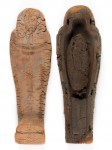 The cedar wood coffin is just 44 centimeters (17 inches) long. It’s a miniature version of a Late Period Egyptian coffin probably dating to between 664 and 525 B.C. The wood has deteriorated over the years, but even through the networks of deep cracks on the exterior and interior of the coffin, the quality of the carving shines. This was an expensive piece.
The cedar wood coffin is just 44 centimeters (17 inches) long. It’s a miniature version of a Late Period Egyptian coffin probably dating to between 664 and 525 B.C. The wood has deteriorated over the years, but even through the networks of deep cracks on the exterior and interior of the coffin, the quality of the carving shines. This was an expensive piece.
Inside the coffin is a bundle wrapped in linen bandages and coated in black resin that was poured over it before the lid was put in place. Because the package is so small, curators thought it contained internal organs that were removed during the mummification process. In preparation for the museum’s bicentennial exhibition Death on the Nile: Uncovering the Afterlife of Ancient Egypt, curators wanted to find out what exactly was in that bundle. X-rays were inconclusive but there were indications that small skeletal material might be present.
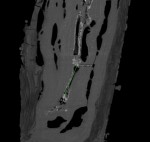 Curators turned to micro CT, scanning the bundle at Cambridge University’s Department of Zoology. Fitzwilliam experts collaborated with radiologist Dr. Tom Turmezei and pediatric radiologist Dr. Owen Arthurs to examine the cross-sectional images produced by the micro CT scans. They concluded that the bundle contained the remains of a very young fetus. The fingers of both hands and toes of both feet are clearly visible, as are the long bones of the legs and arms. The skull and pelvis have collapsed, but the bones that remain allowed researchers to determine the fetus was no more than 18 weeks old. There are no signs in the surviving bones to explain why the fetus was miscarried.
Curators turned to micro CT, scanning the bundle at Cambridge University’s Department of Zoology. Fitzwilliam experts collaborated with radiologist Dr. Tom Turmezei and pediatric radiologist Dr. Owen Arthurs to examine the cross-sectional images produced by the micro CT scans. They concluded that the bundle contained the remains of a very young fetus. The fingers of both hands and toes of both feet are clearly visible, as are the long bones of the legs and arms. The skull and pelvis have collapsed, but the bones that remain allowed researchers to determine the fetus was no more than 18 weeks old. There are no signs in the surviving bones to explain why the fetus was miscarried.
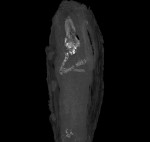 The long bones of the arms are crossed over the chest, which means the tiny fetus was very carefully posed in its tiny coffin. Add to that the careful mummification and elaborate decoration of the coffin, and it’s clear the fetus was of great importance to its bereaved family.
The long bones of the arms are crossed over the chest, which means the tiny fetus was very carefully posed in its tiny coffin. Add to that the careful mummification and elaborate decoration of the coffin, and it’s clear the fetus was of great importance to its bereaved family.
Julie Dawson, Head of Conservation at the Fitzwilliam Museum said, “Using noninvasive modern technology to investigate this extraordinary archaeological find has provided us with striking evidence of how an unborn child might be viewed in ancient Egyptian society. The care taken in the preparation of this burial clearly demonstrates the value placed on life even in the first weeks of its inception.”
Other ancient societies, the Romans, for example, had no such care for dead babies, nevermind miscarried fetuses.
The miniature cedar coffin is now on display at the Death on the Nile exhibition, alongside some truly exquisite artifacts pertaining to Egyptian beliefs about death. It runs through May 22nd, so the clock is ticking if you want to see the exhibition. I’m including all the wonderful images of artifacts in the show that the Fitzwilliam made available to entice those of you who can make it to Cambridge and give those of us who can’t at least a taste of the marvels on display.

